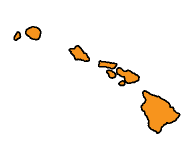Indopacific Tree Gecko
Scientific Name: Hemiphyllodactylus typus / Common Names: Indopacific Tree Gecko
|
These tiny, secretive, insubstantial nocturnal wraiths are the smallest lizards found in Hawaii. Its slender, translucent body is covered in tiny granular scales, and lacks the warty tubercles and spines found on many other geckos. It has a relatively long thin body and proportionately short legs, but only reaches 2.2 - 3.5 in. (6 - 9 cm) TL. The Indopacific Tree Gecko’s most distinguishing characteristic is the rudimentary, clawless inner toe on the forefoot. The lizard’s color varies from almost white at night to light or dark gray or brown. Tiny white flecks and irregular black smudges are scattered along the back. There is a thin black line running from the snout through the eye and across the neck and shoulder. The underside of the tail is orange.
Habitat and Range Unlike other nocturnal geckos, Indopacific Tree Geckos are typically found in forested areas and valleys, not around urban areas. The tree gecko is found on all the larger Hawaiian Islands as well as Lanai. As with most pre-European gecko species, the Indopacific Tree Gecko is native to tropical Asia, from India through Indonesia and New Guinea. It is found across the Pacific from the Solomon Islands to Hawaii. Habits Indopacific Tree Geckos hunt tiny insects and spiders at night on tree trunks and other above ground surfaces, retreating under loose bark or other secure locations by day. All Indopacific Tree Geckos are females, and lay fertile eggs without copulating with a male. They are less vocal than other Hawaiian geckos. Each gecko lays pairs of adherent eggs under bark or other protected location. They are nocturnal and solitary, which, combined with their preference for undisturbed habitats, makes them the least commonly seen gecko in the islands. Similar Species The Indopacific Tree Gecko is the smallest species of gecko in Hawaii, very slender with a rudimentary innermost toe on the forefoot. The Mourning Gecko, another small gecko, is stouter and distinguished by a dark line between eyes, another extending from the tip of the snout through the eye and onto the neck. The Stump-toed Gecko lacks a claw on the inner toes of all four feet. House Geckos are larger, with bigger heads, and their toepads extend to the base of the toe. Tokay Geckos are much larger and distinctly colored, whereas the Day Geckos are diurnal, green in color and have round pupils. Conservation & Other Threats Indopacific Tree Gecko numbers seem to be dwindling, perhaps due to competition or even predation by introduced larger Tokay Geckos and house geckos. Increasing human population is reducing their preferred forest habitat. This species profile relies heavily on: McCoy 1980; McKeown 1996; Zug 1991 |
Size:
Habitat:
Active During:
Diet:
Location:
|






